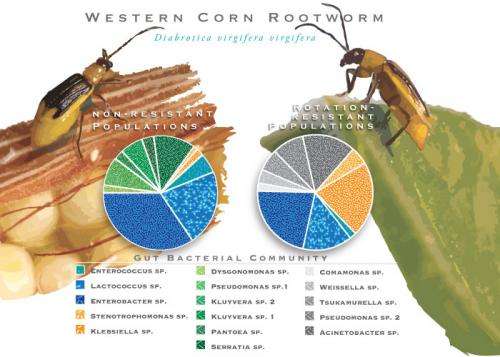Rotation-resistant rootworms owe their success to gut microbes

Researchers say they now know what allows some Western corn rootworms to survive crop rotation, a farming practice that once effectively managed the rootworm pests. The answer to the decades-long mystery of rotation-resistant rootworms lies – in large part – in the rootworm gut, the team reports.
The findings appear in the Proceedings of the National Academy of Sciences.
Differences in the relative abundance of certain bacterial species in the rootworm gut help the adult rootworm beetles feed on soybean leaves and tolerate the plant's defenses a little better, the researchers report. This boost in digestive finesse allows rotation-resistant beetles to survive long enough to lay their eggs in soybean fields. Their larvae emerge the following spring and feast on the roots of newly planted corn.
"These insects, they have only one generation per year," said University of Illinois entomology department senior scientist Manfredo Seufferheld, who led the study. "And yet within a period of about 20 years in Illinois they became resistant to crop rotation. What allowed this insect to adapt so fast? These bacteria, perhaps."
Controlling rootworms is an expensive concern faced by all Midwest corn growers, said study co-author Joseph Spencer, an insect behaviorist at the Illinois Natural History Survey (part of the Prairie Research Institute at the U. of I.). Yield losses, the use of insecticides and corn hybrids engineered to express rootworm-killing toxins in their tissues cost U.S. growers at least $1 billion a year.
In a 2012 study, Seufferheld, Spencer and their colleagues reported that rotation-resistant rootworm beetles were better able than their nonresistant counterparts to tolerate the defensive chemicals produced in soybeans leaves. This allowed the beetles to feed more and survive longer on soybean plants. The researchers found that levels of key digestive enzymes differed significantly between the rotation-resistant and nonresistant rootworms, but differences in the expression of the genes encoding these enzymes did not fully explain the rotation-resistant beetles' advantage. Seufferheld and his colleagues thought that microbes in the rootworms' guts might be helping them better tolerate life in a soybean field.
To test this hypothesis, graduate student Chia-Ching Chu analyzed the population of microbes living in the guts of rootworm beetles collected from seven sites across the Midwest. Some of these sites (including Piper City, Ill.) are hot spots of rotation-resistance and others (in Nebraska and northwest Missouri, for example) lack evidence of rotation-resistant rootworms.
Chu found significant and consistent differences in the relative abundance of various types of bacteria in the guts of rotation-resistant and nonresistant rootworms (see graphic). These differences corresponded to differing activity levels of digestive enzymes in their guts and to their ability to tolerate soybean plant defenses.
The researchers found other parallels between the composition of gut microbes and the life history of the rootworms. The beetles' gut microbial structure corresponded to the insects' level of activity (rotation-resistant rootworms are usually more active), and also paralleled – in a graduated fashion – the plant diversity of the landscapes they inhabited. (Rotation-resistant rootworms are most abundant in regions where rotated corn and soybean fields are the dominant components of the agricultural landscape.)
To determine whether the microbes were in fact giving the rotation-resistant beetles an advantage, the researchers dosed the beetles with antibiotics. Low-level exposure to antibiotics had no effect on any of the beetles, but at higher doses the rotation-resistant beetles' survival time on soybean leaves fell to that of the nonresistant beetles. Antibiotics also lowered the activity of digestive enzymes in the rotation-resistant beetles' guts to that of their nonresistant counterparts.
The message of the research, Seufferheld said, is that the gut microbes are not just passive residents of the rootworm gut.
"They are very active players in the adaptation of the insect," he said. "The microbial community acts as a versatile multicellular organ."
"It's not just the rootworm that we have to worry about," Spencer said. "There's really this whole conspiracy between the rootworm and its co-conspirators in the gut that can respond fairly quickly, relatively speaking, to the assaults that they face."
More information: "Gut Bacteria Facilitate Adaptation to Crop Rotation in the Western Corn Rootworm," www.pnas.org/cgi/doi/10.1073/pnas.1301886110
Journal information: Proceedings of the National Academy of Sciences
Provided by University of Illinois at Urbana-Champaign




















